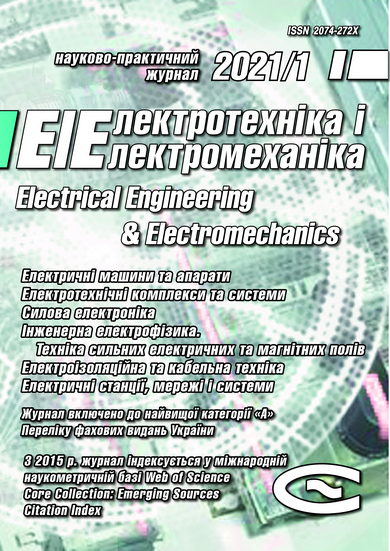On the solution of the problem of synthesis of the control system for the process of dosed feed of electrode wire for arc welding equipment
DOI:
https://doi.org/10.20998/2074-272X.2021.1.04Keywords:
welding process, electrode wire, pulse feed, control system, mathematical description, calculationAbstract
Goal. Refinement of the methodology for the development of an effective control system for an electric drive with controlled relay-type regulators for organizing a metered feed of an electrode wire using the parameters of the arc process with the possibility of using it in design practice and practice of technological application. Methodology. The proposed method for the mathematical description (mathematical model) of the system of the developed structure electric drive - arc process with current feedback of welding with a variable structure device is based on the theory of automatic control as applied to nonlinear elements, the application of the theory of operational calculus. At the same time, a selection and description of a nonlinear node in the feedback circuit in the form of a relay element with a certain structure and subsequent linearization of this element was made. As an electric motor of the electrode wire feeder, a new development of a specialized valve electric motor is used, which is used in the system with a microprocessor controller. Results. Due to the presence of a substantially nonlinear link, the calculation of the valve electric drive system – the arc process can be found on the basis of a system of nonlinear differential equations, which is practically impossible for practical application. In this work, these complications are overcome on the basis of a rational choice of the description of the nonlinear link, its harmonic linearization and obtaining on this basis a mathematical description of the system, from which, using the methodology of operational calculus, the relations necessary for calculating the parameters of the system are determined in analytical form. Originality. The problem of calculating a rather complex problem of mathematical description of the valve electric drive system – a technological link in the form of an arc process with a substantially nonlinear link in the feedback circuit in the work is solved with the effective use of a set of methodological methods, which include as a means of representing individual links, including nonlinear links selected simplifications and solutions of the obtained differential equations using original methods of operational calculus. The proposed method (mathematical model) is tested in two directions – oscillography of a real system, as well as system simulation. Practical significance. Using the developed methods for describing the control system, it is possible to calculate its characteristics and, on their basis, select the parameters for setting the electric drive controller, which allows, without additional experimental research, to obtain the necessary character of the transfer of electrode metal, and, consequently, the quality of the result of the arc process.
References
Paton B.E. Welding problems at the turn of the century. Automatic welding, 1999, no. 1, pp. 4-14. (Rus).
Harris I. Transfer of heat and mass to the base metal in gas metal arc welding. Welding, Brazing, and Soldering, 2011, vol. 6, pp. 82-88.
Paton B.E., Lebedev V.A., Pichak V.G., Poloskov S.Yu. The evolution of pulsed wire feed systems for welding and surfacing. Welding and Diagnostics, 2009, no. 3, pp. 46-51. (Rus).
Zhao Y., Lee P.-S., Chung H. Effect of pulsing parameters on drop transfer dynamics and heat transfer behavior in pulsed gas metal arc welding. International Journal of Heat and Mass Transfer, 2019, vol. 129, pp. 1110-1122. doi: https://doi.org/10.1016/j.ijheatmasstransfer.2018.10.037.
Nadzam J. Tandem GMAW: The Flexibility of Pulsed Spray Transfer. Welding Innovation, 2002, vol. 19, no. 2, pp. 18-21.
Lebedev V.A., Zhuk G.V. Transferal control of electrode metal on the basis of pulsed-type algorithms of system operation with dosing activity of continuous electrode by mechanized arc welding. Heavy Engineering, 2017, no. 6, pp. 27-32. (Rus).
Lebedev V.A., Guly M.V. The high-speed valve electric drive for the equipment of the mechanized arc welding. Mechatronics, automation, control, 2014, no. 6. pp. 47-51. (Rus).
Lebedev V.A. Povyshenie effektivnosti svarochnogo oborudovaniia na osnove issledovaniia impul'snykh vozdeistvii v sisteme podachi elektrodnoi provoloki. Diss. dokt. techn. nauk [Increasing the efficiency of welding equipment based on the study of impulse effects in the electrode wire feed system. Doc. tech. sci. diss.]. Kyiv, 2010. (Rus).
Emelyanov S.V. Teoriya sistem s peremennoj strukturoj [Theory of systems with variable structure]. Moscow, Science Publ. House, 1970. 592 p. (Rus).
Abu-Khalaf M., Huang J., Lewis F.L. Nonlinear H2/H-Infinity Constrained Feedback. Control Springler, 2006. 203 p.
Agachi P.S., Cristea M.V., Csavdari A.A., Szilagyi B. Advanced process engineering control. Walter de Gruyter GmbH, Berlin, Germany, 2017. 412 p.
Besekersky V.A., Popov E.P. Teoriya sistem avtomaticheskogo regulirovaniya [Theory of automatic control systems]. Moscow, Science Publ. House, 1975. 768 p. (Rus).
Downloads
Published
How to Cite
Issue
Section
License
Copyright (c) 2021 V.A. Lebedev

This work is licensed under a Creative Commons Attribution-NonCommercial 4.0 International License.
Authors who publish with this journal agree to the following terms:
1. Authors retain copyright and grant the journal right of first publication with the work simultaneously licensed under a Creative Commons Attribution License that allows others to share the work with an acknowledgement of the work's authorship and initial publication in this journal.
2. Authors are able to enter into separate, additional contractual arrangements for the non-exclusive distribution of the journal's published version of the work (e.g., post it to an institutional repository or publish it in a book), with an acknowledgement of its initial publication in this journal.
3. Authors are permitted and encouraged to post their work online (e.g., in institutional repositories or on their website) prior to and during the submission process, as it can lead to productive exchanges, as well as earlier and greater citation of published work.





